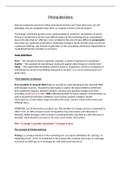Pricing decisions
How do companies set prices? What procedures do they use? Since price wars are self-
defeating, why do companies start them or respond to them in the first place?
Psychology contributes greatly to our understanding of customers’ perceptions of prices.
Pricing is considered to be the most difficult aspect of the marketing mix to comprehend,
due to the idea that an ‘offering’s’ price is linked to the cost of many different components
that make up a particular proposition. Marketing managers rarely controls costs & prices of
a particular offering, and instead usually refers to the accounting and finance department or
marketing/financial controller to set prices.
Some definitions
Price - “the amount of money expected, required, or given in payment for something”
Quality - “the standard of something as measured against other things of a similar kind”
Value – “the regard that something is held to deserve; importance, worth or usefulness of
something; the worth of something compared to its price” E.G. at £12.50 that book is of
good value.
Price elasticity of demand
Price elasticity of demand (PED) helps to provide an understanding of how demand shifts
with changes in prices. Though this information is useful, the data needed to determine
price elasticities requires detailed research, yet price and quantity changes over time. –
According to Bijmolt et al 2005, PED is affected by both ‘brand & category’ characteristics as
well as by general economic conditions, such as time, product category, brand
(manufacturer vs own-label), stage of product life cycle, country, house hold income and
inflation rates.
HOWEVER, not all demands to products are that sensitive to changes in price as opposed to
others. E.G. an 10% increase in price of cigarettes may only lead to a 2% decrease in
demand. Whilst perhaps a 10% increase in washing powder may lead to a 20% decrease in
demand. Some products are seen to be more ‘price elastic’ than others.
PED = % change in quantity demanded / % change in price
The concept of Pricing and Cost
Pricing is a complex element of the marketing mix. (see above definitions for ‘pricing’). In
Marketing terms, ‘price’ is considered as the amount the customer has to pay or exchange
to receive an offering e.g. in exchange for a BK child meal may be £3.
, Proposition costs
In order to price properly, businesses must know what the offering costs to make, produce
or buy. This is because ‘costs’ represent the total money, time and resources sacrificed to
produce or acquire an offering. Typically, a firm will determine what their ‘fixed costs’ are
and what their ‘variable costs’ are for each proposition. Fixed costs do not vary according to
the number of units of goods made or services sold and are thus independent of sales
volume. BY CONTRAST, variable goods depend on the number of units of goods made or
services sold. – E.G. w/ the production of BK burger meals, when sales & demand decrease,
fewer raw goods such as ingredients, packaging and novelty items are required, so less is
spent on raw materials. OTOH, when sales increase more raw materials are needed and
used so spending rises.
Relationship between pricing and proposition costs
This relationship is deemed important, as costs should be substantially less than the price
assigned to an offering, otherwise the business won’t sell sufficient units to obtain sufficient
revenues and make long term profits.
Total revenue = unit price x volume sold
Profit = total revenue – total costs
The price at which an offering is set is vital, as increases in price tend to have a
disproportionately positive effect on profits and decreases in price have disproportionately
negative effect on profits. A study done by Baker et al 2010:5 identified that:
A 1% improvement in price achieves an 8.7% improvement in operating profit
A 1% improvement in variable costs achieves only a 5.9% improvement in operating
profit
A 1% improvement in volume sales achieves a 2.8% improvement in operating profit
A 1% improvement in fixed costs achieves only a 1.8% improvement in operating
profits
Therefore, whenever possible, businesses should aim to increase prices. HOWEVER,
deciding how to price a proposition is complex and customers seldom want to pay more.
To increase the accuracy of the cost data, we need to spend more time collecting and
analysing it. determining costs is an exercise where we trade off accuracy with the benefits
and costs of data collection, storage and processing – Babad and Balachandran 1993.
(still linked to relationship between pricing and proposition costs)
Customer Perceptions of Price, Quality and Value
Marketers are concerned with how individuals react to the way offering are priced, thus
questioning how consumers perceive prices and why they perceive them as they do. These
individual perceptions are considered w/ their relationship to customer responses to price:




